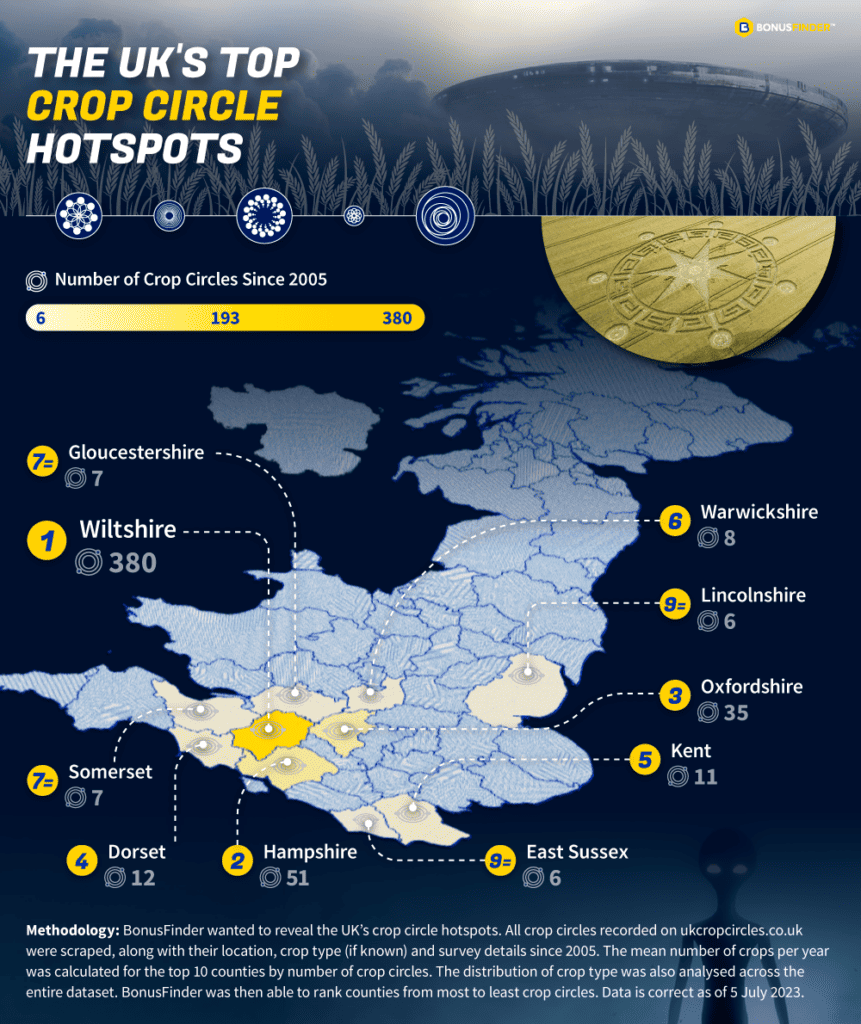
Trying to think of fun and unique ways to occupy your time this Summer? Look no further than the phenomena of crop circles that are not only great to learn about the history of the English countryside but also spark imagination as to how the circles were made.
So which circles. They scraped records of crop circles since 2005, along with their location, crop type, and survey details in order to establish the county with the highest number of crop circles.
Key results:
- Wiltshire is the UK crop circle hotspot! With its idyllic villages and the iconic Salisbury Cathedral, it surpasses all other counties, boasting a staggering 380 crop circles since 2005.
- The South East county of Hampshire follows in second place with 51 crop circles.

Wiltshire is the UK’s crop circle hotspot with an impressive 380 crop circles having appeared in the county since 2005. Crop circles in Wiltshire often emerge in fields of wheat and barley where shapes are flattened into the vegetation. The county’s idyllic rolling hills and farming land provide the ideal framework for these creations. If you are looking for a day out, why not plan a walking tour of the Wiltshire countryside and explore the iconic Uffington White Horse which is a chalk figure over 3,000 years old. It is well known that crop circles are often found in the fields surrounding the white horse so keep your eyes peeled! Likewise, around a forty minute drive away is the historical village and World Heritage Site of Avebury where you will often find crop circles in the surrounding fields. The most recent formation in the county was observed on the 28th of May 2023 in Broad Hinton and is described as a six-fold spinner with standing ‘arms’ within a laid circle and a central unbroken ring of standing stems with a flattened centre.
The South East county of Hampshire comes second with 51 crop circles. Known for the historical Winchester Cathedral and expansive countryside, Hampshire is a great place to go on a crop circle hunt, as it is home to many beautiful and mysterious crop circles. Chilcomb in Hampshire saw the most recent formation on the 12th of July 2022 with a series of laid circles and rings contained within a narrow outer ring. If you are wanting to observe these formations, seek out permission from the farmer prior to visit.
In third place is the county of Oxfordshire with 35 crop circles recorded. Once again, the scenic countryside offers a perfect landscape for these formations with complex geometric designs. Crop circles in the area are often found in remote locations so you must be prepared to walk and when you do find one, do not touch as it could damage the pattern and make it harder for scientists to study. The most recent formation was discovered on the 9th of August 2020 in Uffington Castle and is described as a wheat formation with concentric, rotating, triangular elements around the central circle and standing ring. As well as this, why not take a walk along The Cherwell Valley River as crop circles are known to be found in the fields along this stretch on a few occasions!
Researcher shares expertise on crop circles
Monique Klinkenbergh, researcher and founder of the Crop Circle Visitor Centre & Exhibition, gives insight into why Wiltshire is the UK’s crop circle capital:
- What is the reason for the prevalence of crop circles in Wiltshire?
“Crop circles seem to be attracted by ancient sites such as stone circles, long barrows, hill forts and other archaeological sites, for which Wiltshire is famous. One of the earliest theories for this attraction is the idea that what has been built by our far ancestors on ancient sites, marked by what has always been part of the landscape: Earth Energies. Those energies – the so called ley-lines – are said to run invisibly through the landscape concentrating at crossing points where they also emerge to the surface. Experienced dowsers report detectable energetic changes within crop circles.
The Underground Connection, another theory on why Wiltshire is a focus-point for crop circle activity, describes the presence of chalk and green sand rock in combination with large aquifers. The high mineral content of the major aquifers of England makes them good conductors of electricity, possibly derived through interaction with the Earth’s electromagnetic field. The alkaline chalk is saturated with water. Beneath is a lint-rich clay and the top ridges of the chalk Downs are topped by a thin layer of lint. Therefore there is an alkaline solution sandwiched on either side by acidic layers. The theory of Broughton and Page is that this attracts and is then activated and ‘charged up’ by the powerful currents of energy flowing through the ground.”
- What are the types of crop circles you tend to see in Wiltshire?
“We have had so many different designs appearing, from small simple circles and ‘pictograms’ to extremely intricate and large patterns. Sometimes with a very detailed and complex lay on the ground (lay: the way the plants are laid down). Some crop circle patterns are familiar in design, suggesting they belong to a certain ‘school’ or ‘family-type’, such as Mathematical, Forms of Life, Religious, Astronomical, Codes and Mythology.”
- How are crop circles formed?
“There are many ideas, hypotheses and theories, ranging from extraterrestrial involvement, the paranormal, spirits of the dead, the universe, sound frequencies (recorded on tape), balls of light (recorded on camera) and nature itself. They might be all interconnected. The eyewitness reports (50+ credible accounts) all have one thing in common; the crop flattening process is described as happening in a matter of seconds and being done by an invisible source. One hypothesis regarding the origin of crop circles – a theory which all researchers agree on – is that some could be the result of an ‘interaction’ between a person’s thoughts and the energy/force that forms the crop circle. There are many reports of people who requested or wished for a crop circle to be manifested for them and finding one had appeared. Some experiments have been successful and may open a new way of understanding the principles at work.”
- What tools do you suspect are used?
“The man-made tools that are used are planks and ropes. Also, some believe that crop circles are made by hidden agencies using space satellite lasers or other science fiction devices to conduct training, environmental control or simply to study how people will react.”
| Since 2005 | Since 2010 | Since 2015 | ||||
|---|---|---|---|---|---|---|
| County | Number of Crops | Mean | Number of Crops | Mean | Number of Crops | Mean |
| Wiltshire | 380.0 | 20.540540540541 | 286.0 | 21.185185185185 | 95.0 | 11.176470588235 |
| Hampshire | 51.0 | 2.7567567567568 | 39.0 | 2.8888888888889 | 24.0 | 2.8235294117647 |
| Oxfordshire | 35.0 | 1.8918918918919 | 14.0 | 1.037037037037 | 5.0 | 0.58823529411765 |
| Dorset | 12.0 | 0.64864864864865 | 11.0 | 0.81481481481481 | 5.0 | 0.58823529411765 |
| Kent | 11.0 | 0.59459459459459 | 0.0 | 0 | 0.0 | 0 |
| Warwickshire | 8.0 | 0.43243243243243 | 8.0 | 0.59259259259259 | 2.0 | 0.23529411764706 |
| Gloucestershire | 7.0 | 0.37837837837838 | 6.0 | 0.44444444444444 | 2.0 | 0.23529411764706 |
| Somerset | 7.0 | 0.37837837837838 | 4.0 | 0.2962962962963 | 1.0 | 0.11764705882353 |
| East Sussex | 6.0 | 0.32432432432432 | 3.0 | 0.22222222222222 | 0.0 | 0 |
| Lincolnshire | 6.0 | 0.32432432432432 | 4.0 | 0.2962962962963 | 0.0 | 0 |
